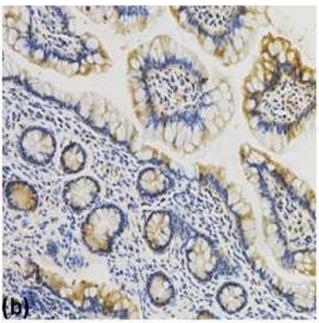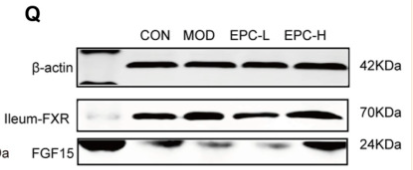FGF19 Antibody - #DF2651
| Product: | FGF19 Antibody |
| Catalog: | DF2651 |
| Description: | Rabbit polyclonal antibody to FGF19 |
| Application: | WB IHC |
| Cited expt.: | WB, IHC |
| Reactivity: | Human, Rat |
| Prediction: | Pig, Zebrafish, Bovine, Rabbit, Dog |
| Mol.Wt.: | 24 kDa; 24kD(Calculated). |
| Uniprot: | O95750 |
| RRID: | AB_2839857 |
Related Downloads
Protocols
Product Info
*The optimal dilutions should be determined by the end user. For optimal experimental results, antibody reuse is not recommended.
*Tips:
WB: For western blot detection of denatured protein samples. IHC: For immunohistochemical detection of paraffin sections (IHC-p) or frozen sections (IHC-f) of tissue samples. IF/ICC: For immunofluorescence detection of cell samples. ELISA(peptide): For ELISA detection of antigenic peptide.
Cite Format: Affinity Biosciences Cat# DF2651, RRID:AB_2839857.
Fold/Unfold
FGF 19; FGF-19; FGF15; FGF19; FGF19_HUMAN; Fibroblast growth factor 15; Fibroblast growth factor 19;
Immunogens
A synthesized peptide derived from human FGF19, corresponding to a region within C-terminal amino acids.
- O95750 FGF19_HUMAN:
- Protein BLAST With
- NCBI/
- ExPASy/
- Uniprot
MRSGCVVVHVWILAGLWLAVAGRPLAFSDAGPHVHYGWGDPIRLRHLYTSGPHGLSSCFLRIRADGVVDCARGQSAHSLLEIKAVALRTVAIKGVHSVRYLCMGADGKMQGLLQYSEEDCAFEEEIRPDGYNVYRSEKHRLPVSLSSAKQRQLYKNRGFLPLSHFLPMLPMVPEEPEDLRGHLESDMFSSPLETDSMDPFGLVTGLEAVRSPSFEK
Predictions
Score>80(red) has high confidence and is suggested to be used for WB detection. *The prediction model is mainly based on the alignment of immunogen sequences, the results are for reference only, not as the basis of quality assurance.
High(score>80) Medium(80>score>50) Low(score<50) No confidence
Research Backgrounds
Involved in the suppression of bile acid biosynthesis through down-regulation of CYP7A1 expression, following positive regulation of the JNK and ERK1/2 cascades. Stimulates glucose uptake in adipocytes. Activity requires the presence of KLB and FGFR4.
Secreted.
Expressed in fetal brain, cartilage, retina, and adult gall bladder.
Belongs to the heparin-binding growth factors family.
Research Fields
· Cellular Processes > Cell motility > Regulation of actin cytoskeleton. (View pathway)
· Environmental Information Processing > Signal transduction > MAPK signaling pathway. (View pathway)
· Environmental Information Processing > Signal transduction > Ras signaling pathway. (View pathway)
· Environmental Information Processing > Signal transduction > Rap1 signaling pathway. (View pathway)
· Environmental Information Processing > Signal transduction > PI3K-Akt signaling pathway. (View pathway)
· Human Diseases > Cancers: Overview > Pathways in cancer. (View pathway)
· Human Diseases > Cancers: Specific types > Melanoma. (View pathway)
· Human Diseases > Cancers: Specific types > Breast cancer. (View pathway)
· Human Diseases > Cancers: Specific types > Gastric cancer. (View pathway)
References
Application: WB Species: Rat Sample:
Application: WB Species: Rat Sample:
Application: IHC Species: Human Sample: ileum tissue
Application: IHC Species: human Sample: terminal ileum mucosa epithelial cells
Restrictive clause
Affinity Biosciences tests all products strictly. Citations are provided as a resource for additional applications that have not been validated by Affinity Biosciences. Please choose the appropriate format for each application and consult Materials and Methods sections for additional details about the use of any product in these publications.
For Research Use Only.
Not for use in diagnostic or therapeutic procedures. Not for resale. Not for distribution without written consent. Affinity Biosciences will not be held responsible for patent infringement or other violations that may occur with the use of our products. Affinity Biosciences, Affinity Biosciences Logo and all other trademarks are the property of Affinity Biosciences LTD.



